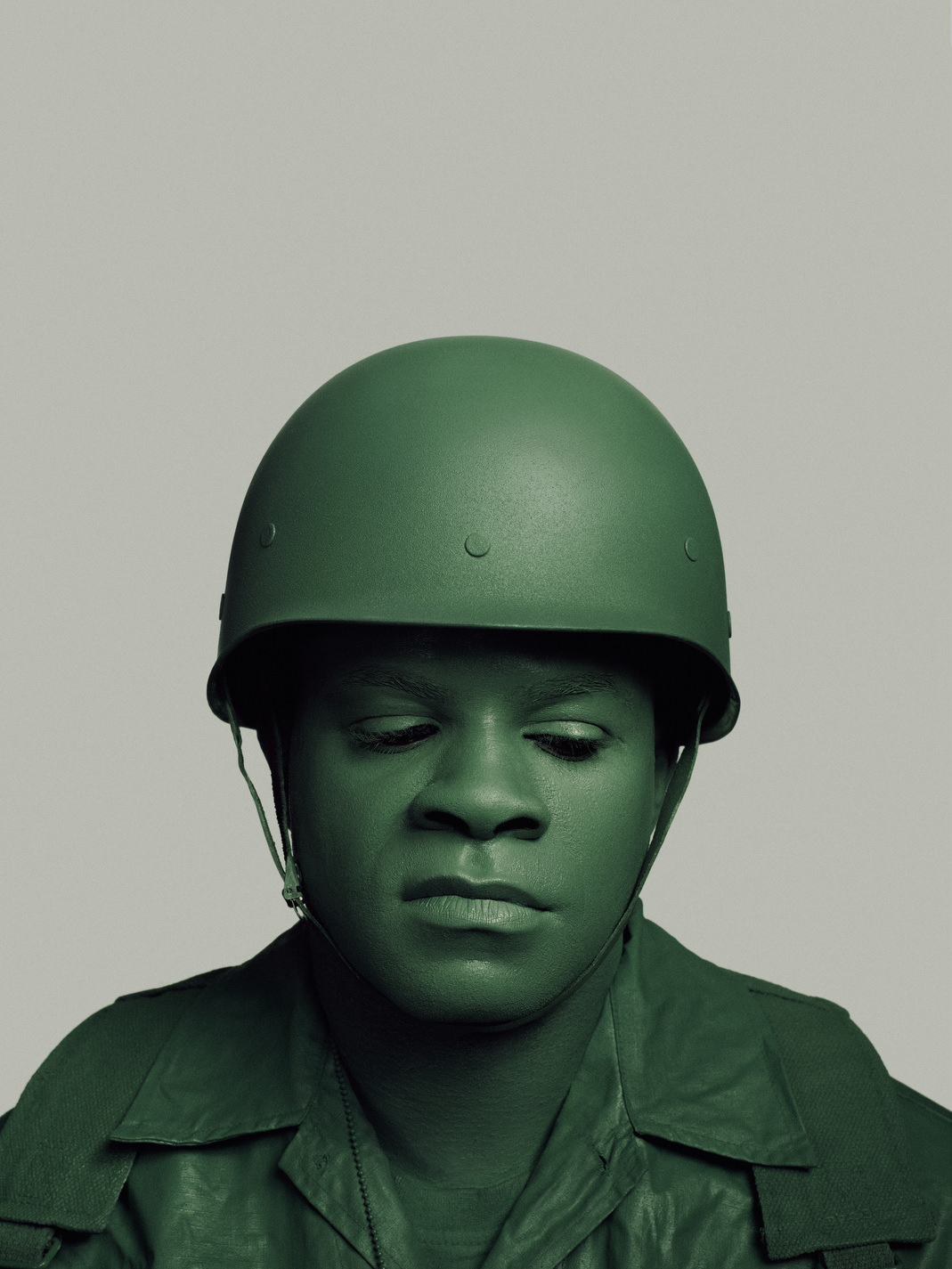017-33-7392 © John Keatley
While John Keatley is most widely known for his commercial photography and advertising campaigns, shooting everyone from Anthony Hopkins to Macklemore with punchy, studio lit, conceptually-driven portraiture, his latest personal series Uniform treads on darker territory. Using some of the same commercial aesthetics and devices of his campaign work, the Seattle-based photographer aims to create conversation on how many Americans perceive, and often distance themselves from the soldiers that make up the United States military.
062-31-5497 © John Keatley
Uniform is a straightforward, nearly monochromatic grouping of sixteen serialized portraits of actors and models painted and costumed like plastic green army men toys. Keatley photographs them with clean, nondescript lighting, in front of generic gray backgrounds that, like most typologies, allow the viewer to make closer individual scrutiny. Some gestures are cartoonish and exaggerated, playing on classic pop-cultural images of the military.
In one image, for example, a moustached man bites a thick green cigar, like a character straight out of MASH, or Full Metal Jacket. Others, however, despite the implied sterility of green plastic, are tender and empathetic, showing more contemplative moments and mid-thought gazes. For Keatley, these images help humanize soldiers who he feels are too often reduced to the caricatures of their synthetic counterparts. “By dipping our soldiers in green plastic and shrinking them down,” writes Keatley, “we muffle their humanity and reduce their greatness.”
The series was inspired by a family vacation to Disneyland Keatley made several years ago. One afternoon, while wandering around one of the parks, they saw a green army truck with four men painted to resemble the little green men – smiling and waving with confidence. While these figures had existed for generations, seeing them for the first time in person made an unexpected impact on Keatley. “It was the idea of the toy given human context that hit me,” he says. Keatley was struck not only by what seemed like a sterilization of the impact of war, but the cartoonish sterilization of soldiers. While on some level, they may have appeared heroic, they felt removed, cast as “others,” lacking humanity.
While women serve and fight in today's military, Keatley opted to only use male actors for this series in an effort to replicate the toys of the period. "The style and historical reference for Uniform was the Vietnam War, and the toys from that period are all male." he says. "I did decide to include much broader diversity in the casting," he adds, which may be less accurate to the toys he's referencing. Ultimately, despite taking a consciously homogeneous approach to gender, Keatley felt it was important to show similarities across cultural divides.
While Uniform might at first glance read as a one-dimensional statement about war and the military, its layers address the barriers we construct to avoid empathy. “I do appreciate that Uniform can speak to those who have been affected by the military and war,” says Keatley, “but my hope is that people take away much more than that. There are so many different perspectives right here in our own towns and cities. We need to drop our arrogance and assumptions that our opinions are the best, or only ways to look at life.” For Keatley, the gestures and expressions of his anthropomorphic toys are a metaphor for the social and political silos we often fall into. “When we build walls around ourselves and distance ourselves from others who are different - that’s when we start treating others like they are little plastic green toys with no regard."
003-23-9294 © John Keatley
021-59-1397 © John Keatley
009-36-2122 © John Keatley
015_74_9121 © John Keatley
013-71-8924 © John Keatley
Bio: John Keatley often self-characterizes his work as a reflection of himself, rather than the individual he is photographing. His clients include BECU, Seattle Humane, SFMOMA, and Hotels.com, and his work has been recognized in American Photography 31, Applied Arts, PDN, and LeBook, among others. In recent years, his journey of self-discovery has brought clarity to emotions that have always been present yet were previously unknown. Anxiety. Fear. Isolation. Not Being In Control. Keatley capitalizes on the correlation between these emotions and humor. It is a fine line, sitting in the pain of the emotion and understanding that pain can also be humorous. Yet John beautifully executes this dichotomy in his work, as the viewer is invited to stay a moment longer and ponder the unexpected. His clients include BECU, Seattle Humane, SFMOMA, and Hotels.com, and his work has been recognized in American Photography 31, Applied Arts, PDN, and LeBook, among others.







